Archean Rocks of the Diorite Window Block in the Southern Framing of the Monchegorsk (2.5 Ga) Layered Mafic-Ultramafic Complex (Kola Peninsula, Russia)
Abstract
:1. Introduction
2. Geological Structure of the Monchegorsk Complex
3. Gabbro-10 Massif: Structure, Petrography, Geochemistry, and Geochronology of the Metadiorites
4. Materials and Methods
5. Results
5.1. Geological Features of the DW Block
5.2. Petrography
5.3. Chemical Composition of Tourmaline and Garnet
5.4. Petrochemical Description of the DW Rocks
5.5. Ore Mineralization
5.6. Geochronology of the DW Rocks
5.6.1. U–Pb Zircon Geochronology
5.6.2. Sm-Nd Geochronology
6. Discussion
7. Conclusions
Author Contributions
Funding
Acknowledgments
Conflicts of Interest
References
- Kozlov, E.K. Natural Series of Rocks of the Nickel-Bearing Intrusions and Their Metallogeny; Nauka: Leningrad, Russia, 1973. [Google Scholar]
- Yudin, B.A. Gabbro-Labradorite Formation of the Kola Peninsula and Its Metallogeny; Nauka: Leningrad, Russia, 1980. [Google Scholar]
- Smolkin, V.F.; Fedotov, Z.A.; Orsoev, D.A.; Ohnenstetter, D. Ore-bearing layered Monchepluton. In Layered Intrusions of the Monchegorsk Ore Region: Petrology, Mineralization, Isotopy, Deep Structure. Part 1; Mitrofanov, F.P., Smolkin, V.F., Eds.; KSC RAS: Apatity, Russia, 2004; pp. 36–75. [Google Scholar]
- Bayanova, T. Age of Reference Geological Complexes of the Kola Region and the Duration of Magmatic Processes; Nauka: St. Petersburg, Russia, 2004. [Google Scholar]
- Grokhovskaya, T.L.; Lapina, M.I.; Muravitskaya, G.N.; Bakaev, G.F.; Sholokhnev, V.V.; Voitekhovich, V.S. The PGE Ore Mineralization in the Monchegorsk Magmatic Layered Complex (Kola Peninsula, Russia); Nauka: St. Petersburg, Russia, 2003; Volume 45. [Google Scholar]
- Sharkov, E.V.; Chistyakov, A.V. Geological and petrological aspects of Ni-Cu-PGE mineralization in the early Paleoproterozoic Monchegorsk layered mafic-ultramafic complex, Kola peninsula. Geol. Ore Depos. 2014, 56, 147–168. [Google Scholar] [CrossRef]
- Chashchin, V.V.; Mitrofanov, F.P. The Paleoproterozoic Imandra-Varzuga rifting structure (Kola peninsula): Intrusive magmatism and minerageny. Geodyn. Tectonophys. 2014, 5, 231–256. [Google Scholar] [CrossRef] [Green Version]
- Pripachkin, P.V.; Rundkvist, T.V.; Miroshnikova, Y.A.; Chernyavsky, A.V.; Borisenko, E.S. Geological structure and ore mineralization of the South Sopchinsky and Gabbro-10 massifs and the Moroshkovoe Lake target, Monchegorsk area, Kola peninsula, Russia. Miner. Depos. 2016, 51, 973–992. [Google Scholar] [CrossRef]
- Grebnev, R.A.; Rundkvist, T.V.; Pripachkin, P.V. Geochemistry of mafic rocks of the PGE-bearing Vurechuaivench Massif (Monchegorsk Complex, Kola region). Geochem. Int. 2014, 52, 726–739. [Google Scholar] [CrossRef]
- Rundqvist, T.V.; Pripachkin, P.V.; Bazai, A.V. Plagioclase Composition in Rocks of PGE-Bearing Layered Series in the Vurechuaivench Massif, Monchegorsk Complex, Kola region. Geol. Ore Depos. 2018, 60, 736–743. [Google Scholar] [CrossRef]
- Ivanchenko, V.N.; Davydov, P.S.; Dedeev, V.A.; Knauf, V.V. Major features of the Vuruchuaivench (Vurechuaivench) deposit geological structure. In The Neighborhood Cooperation and Experience Exchange for Geological Prospecting and Survey of PGE Deposits in the Northen Fennoscandia. An Interreg-Tacis Project N KA-0197 Vol. 1; KSC RAS: Apatity, Russia, 2008; pp. 82–87. [Google Scholar]
- Groshev, N.Y.; Pripachkin, P.V. To the question of the geological position and PGE mineralization of the Gabbro-10 massif, Monchegorsk complex, Kola region. Ores Met. 2018, 4, 4–13. [Google Scholar]
- Groshev, N.Y.; Pripachkin, P.V.; Karykowski, B.T.; Malygina, A.V.; Rodionov, N.V.; Belyatsky, B.V. Genesis of a magnetite layer in the Gabbro-10 intrusion, Monchegorsk complex, Kola region: U–Pb SHRIMP-II dating of metadiorites. Geol. Ore Depos. 2018, 60, 486–496. [Google Scholar] [CrossRef]
- Karykowski, B.T.; Maier, W.D.; Groshev, N.Y.; Barnes, S.J.; Pripachkin, P.V.; McDonald, I.; Savard, D. Critical controls on the formation of contact-style PGE-Ni-Cu mineralization: Evidence from the paleoproterozoic Monchegorsk complex, Kola region, Russia. Econ. Geol. 2018, 113, 911–935. [Google Scholar] [CrossRef]
- Efimov, A.A.; Subbotin, V.V.; Vursiy, G.L. Geological structure and characterization of sulfide PGE-bearing mineralization of the Gabbro-10 massif (Monchegorsk intrusion, Kola peninsula). In Proceedings of the Materials of the XV Conference of Young Scientists Dedicated to the Memory of K.O. Kratcs, St. Petersburg, Russia, 13–16 October 2004; pp. 726–739. [Google Scholar]
- Serov, P.A.; Bayanova, T.B.; Steshenko, E.N.; Kunakkuzin, E.L.; Borisenko, E.S. Metallogenic Setting and evolution of the Pados-Tundra Cr-bearing ultramafic complex, Kola peninsula: Evidence from Sm–Nd and U–Pb Isotopes. Minerals 2020, 10, 186. [Google Scholar] [CrossRef] [Green Version]
- Ludwig, K.R. A geochronological toolkit for Microsoft Excel, Version 3.6. Berkeley Geochronol. Cent. Spec. Publ. 2008, 4, 1–76. [Google Scholar]
- Williams, I.S. U-Th-Pb Geochronology by Ion Microprobe. In Applications of Microanalytical Techniques to Understanding Mineralizing Processes. Reviews in Economic Geology; McKibben, M.A., Shanks, W., III, Ridley, W.I., Eds.; Society of Economic Geologists: Littleton, CO, USA, 1998; Volume 7, pp. 1–35. ISBN 1-887483-51-9. [Google Scholar]
- Schuth, S.; Gornyy, V.I.; Berndt, J.; Shevchenko, S.S.; Sergeev, S.A.; Karpuzov, A.F.; Mansfeldt, T. Early proterozoic U-Pb zircon ages from basement gneiss at the Solovetsky archipelago, White Sea, Russia. Int. J. Geosci. 2012, 3, 289–296. [Google Scholar] [CrossRef] [Green Version]
- Ludwig, K.R. A geochronological toolkit for Microsoft Excel, Version 2.06. Berkeley Geochronol. Cent. Spec. Publ. 1999, 1a, 1–49. [Google Scholar]
- Hölttä, P.; Heilimo, E.; Huhma, H.; Kontinen, A.; Mertanen, S.; Mikkola, P.; Paavola, J.; Peltonen, P.; Semprich, J.; Slabunov, A.; et al. The Archaean Karelia and Belomorian provinces, Fennoscandian shield. In Evolution of Archean Crust and Early Life, Modern Approaches in Solid Earth Sciences 7; Dilek, Y., Furnes, H., Eds.; Springer: Dordrecht, The Netherlands, 2014; pp. 55–102. [Google Scholar]
- Middlemost, E.A.K. Naming materials in the magma/igneous rock system. Earth Sci. Rev. 1994, 37, 215–224. [Google Scholar] [CrossRef]
- Condie, K.C. How to make a continent: Thirty-five years of TTG research. In Modern Approaches in Solid Earth Sciences; Springer International Publishing: Dordrecht, The Netherlands, 2014; Volume 7, pp. 179–193. [Google Scholar]
- Hölttä, P.; Balagansky, V.; Garde, A.A.; Mertanen, S.; Peltonen, P.; Slabunov, A.; Sorjonen-Ward, P.; Whitehouse, M. Archean of Greenland and Fennoscandia. Episodes 2008, 31, 13–19. [Google Scholar] [CrossRef] [Green Version]
- Käpyaho, A.; Mänttäri, I.; Huhma, H. Growth of Archaean crust in the Kuhmo district, eastern Finland: U-Pb and Sm-Nd isotope constraints on plutonic rocks. Precambrian Res. 2006, 146, 95–119. [Google Scholar] [CrossRef]
- Mikkola, P.; Huhma, H.; Heilimo, E.; Whitehouse, M. Archean crustal evolution of the Suomussalmi district as part of the Kianta Complex, Karelia: Constraints from geochemistry and isotopes of granitoids. Lithos 2011, 125, 287–307. [Google Scholar] [CrossRef]
- Sun, S.-S.; McDonough, W.F. Chemical and isotopic systematics of oceanic basalts: Implications for mantle composition and processes. Geol. Soc. London Spec. Publ. 1989, 42, 313–345. [Google Scholar] [CrossRef]
- McDonough, W.F.; Sun, S.-S. The composition of the Earth. Chem. Geol. 1995, 120, 223–253. [Google Scholar]
- Rundkvist, T.V.; Pripachkin, P.V.; Grebnev, R.A. On the problem of geological setting and distribution of PGE-mineralization in the Eastern part of the Monchegorsk complex (Kola peninsula)—On the basis of cumulus stratigraphy data. In Strategic Mineral Resources of Lapland—Base for the Sustainable Development of the North. An Interreg-Tacis Project N KA-0197, Vol. 2; Mitrofanov, F.P., Iljna, M., Zhirov, D., Eds.; KSC RAS: Apatity, Russia, 2009; pp. 51–64. ISBN 978-5-91137-094-7. [Google Scholar]
- Hölttä, P.; Heilimo, E.; Huhma, H.; Kontinen, A.; Lauri, L.; Slabunov, A. Paleoarchean Rocks in the Fennoscandian Shield. In Earth’s Oldest Rocks; Van Kranendonk, M., Bennett, V., Hoffmann, E., Eds.; Elsevier: Amsterdam, The Netherlands, 2019; pp. 819–835. [Google Scholar]
- Slabunov, A.I.; Lobach-Zhuchenko, S.B.; Bibikova, E.V.; Sorjonen-Ward, P.; Balagansky, V.V.; Volodichev, O.I.; Shchipansky, A.A.; Svetov, S.A.; Chekulaev, V.P.; Arestova, N.A.; et al. The Archaean nucleus of the Fennoscandian (Baltic) shield. Geol. Soc. Mem. 2006, 32, 627–644. [Google Scholar] [CrossRef]
- Hölttä, P.; Heilimo, E.; Huhma, H.; Kontinen, A.; Mertanen, S.; Mikkola, P.; Paavola, J.; Peltonen, P.; Semprich, J.; Slabunov, A.; et al. The archaean of the Karelia province in Finland. In Geological Survey of Finland Special Paper 54; Hölttä, P., Ed.; Geological Survey of Finland: Espoo, Finland, 2012; pp. 21–73. [Google Scholar]
- Morozova, L.N.; Bayanova, T.B.; Serov, P.A. The main stages of granite formation in the Archean of the northeast part of the Baltic Shield (on the example of the Voche-Lambina test site). Lithosphere 2011, 6, 14–26. [Google Scholar]
- Corfu, F.; Hanchar, J.; Hoskin, P.W.O.; Kinny, P. Atlas of Zircon Textures. Rev. Mineral. Geochem. 2003, 53, 469–500. [Google Scholar] [CrossRef]
- Melezhik, V.A.; Sturt, B.A. General geology and evolutionary history of the early proterozoic Polmak-Pasvik-Pechenga-Imandra/Varzuga-Ust’Ponoy greenstone belt in the northeastern Baltic Shield. Earth Sci. Rev. 1994, 36, 205–241. [Google Scholar] [CrossRef]
- Korja, A.; Lahtinen, R.; Nironen, M. The Svecofennian orogen: A collage of microcontinents and island arcs. Geol. Soc. Mem. 2006, 32, 561–578. [Google Scholar] [CrossRef]
- Chashchin, V.V.; Bayanova, T.B.; Mitrofanov, F.P.; Serov, P.A. Low-Sulfide PGE ores in paleoproterozoic Monchegorsk pluton and massifs of its southern framing, Kola Peninsula, Russia: Geological characteristic and isotopic geochronological evidence of polychronous ore–magmatic systems. Geol. Ore Depos. 2016, 58, 37–57. [Google Scholar] [CrossRef]
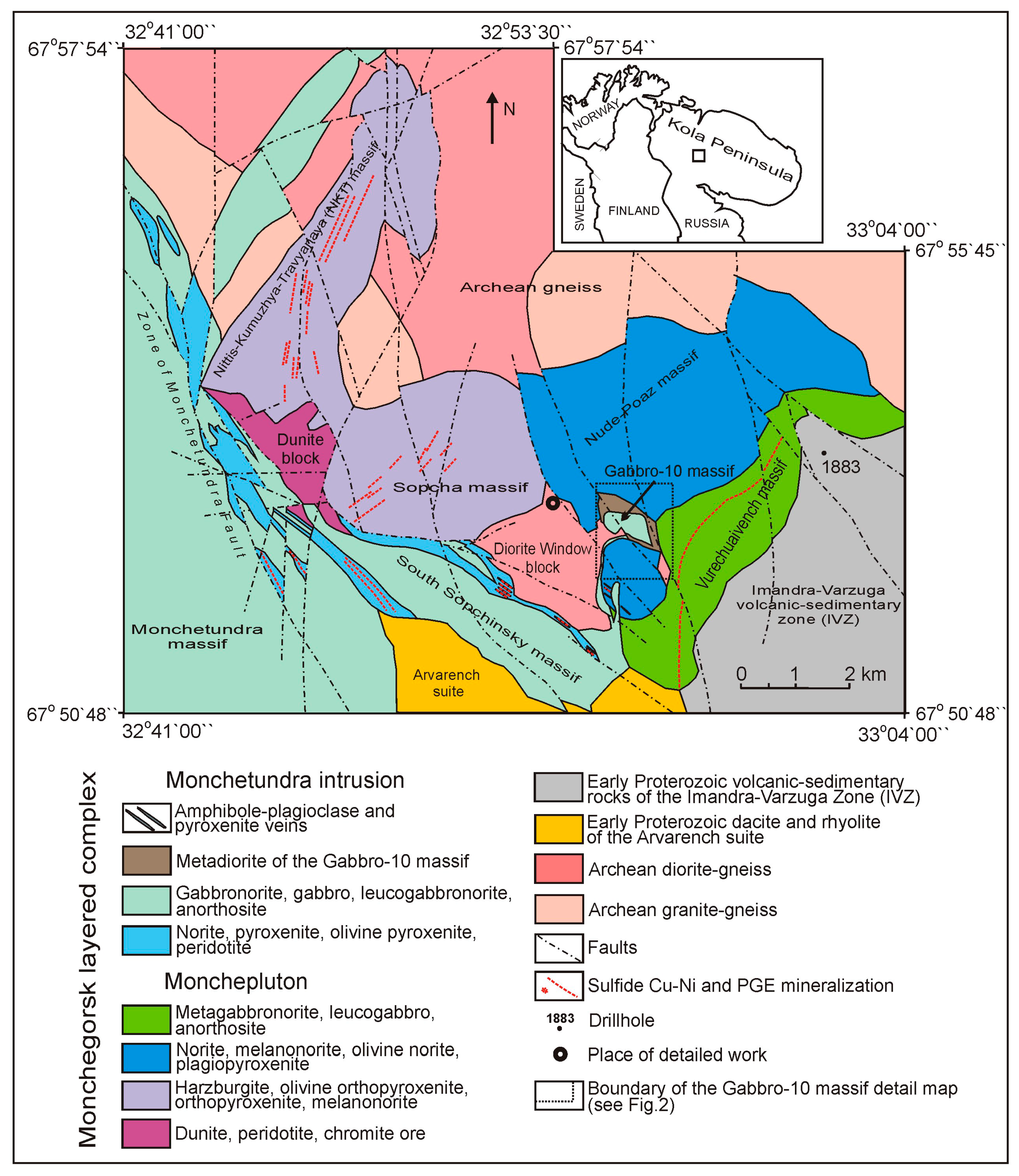
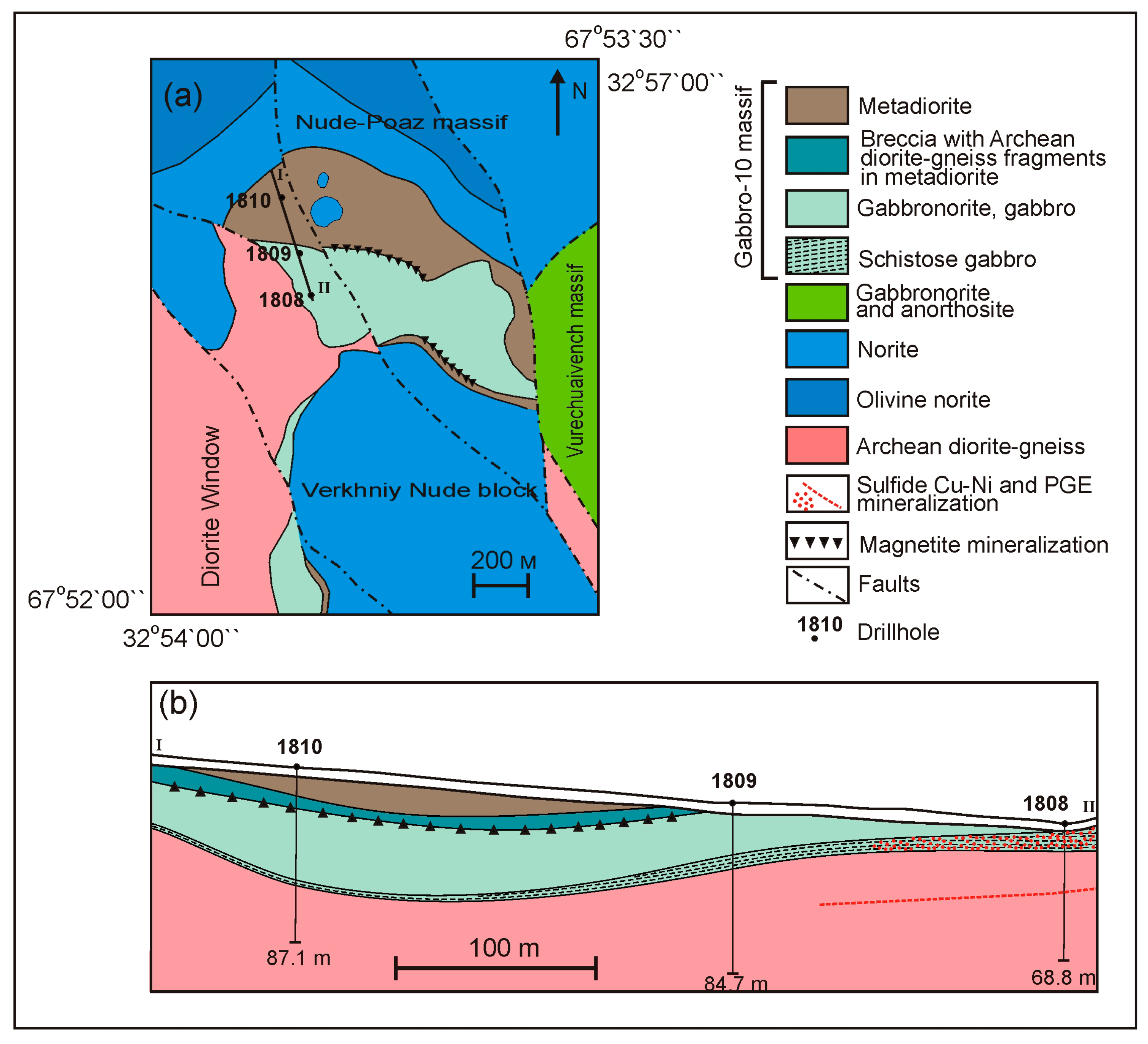

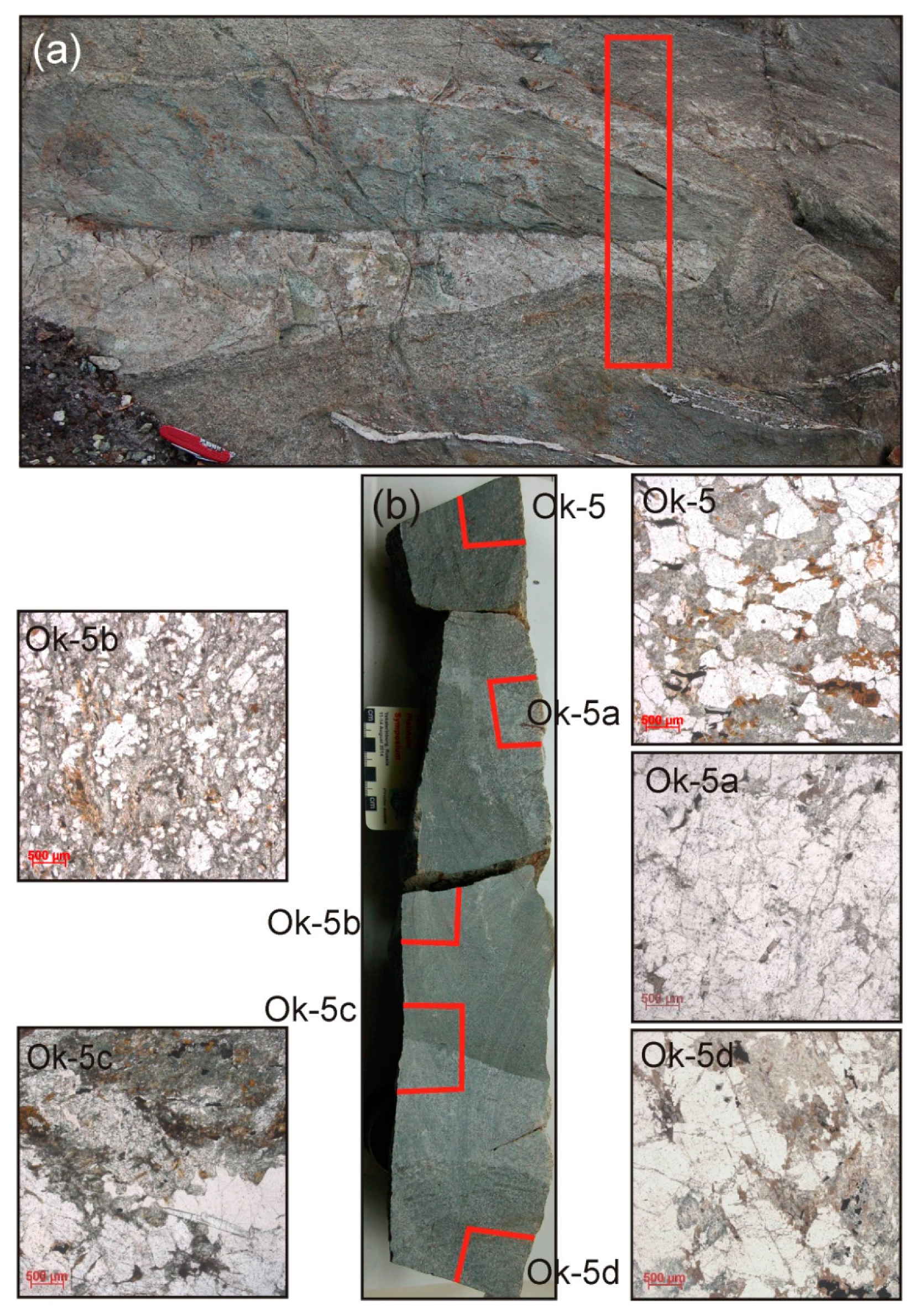

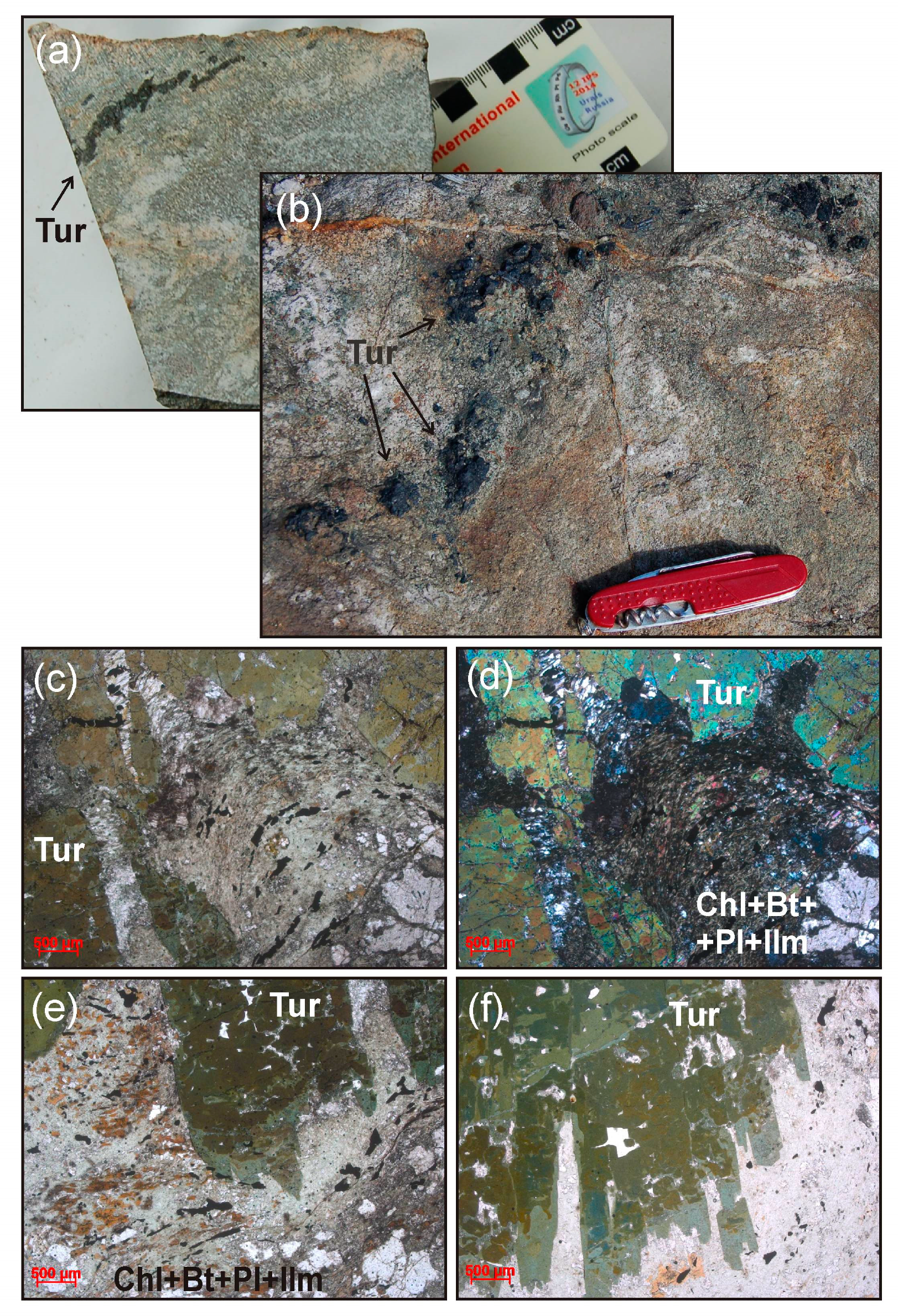
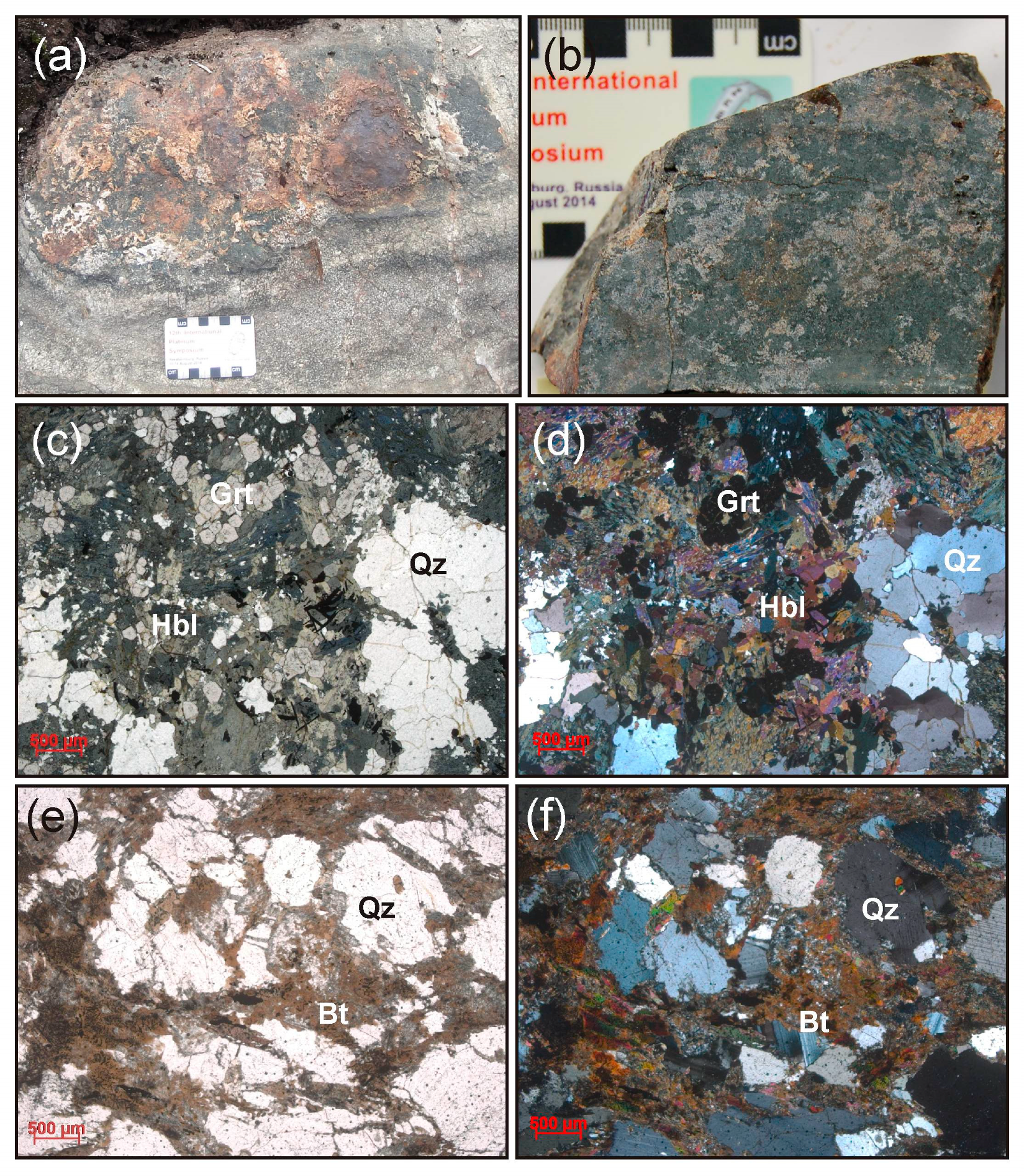
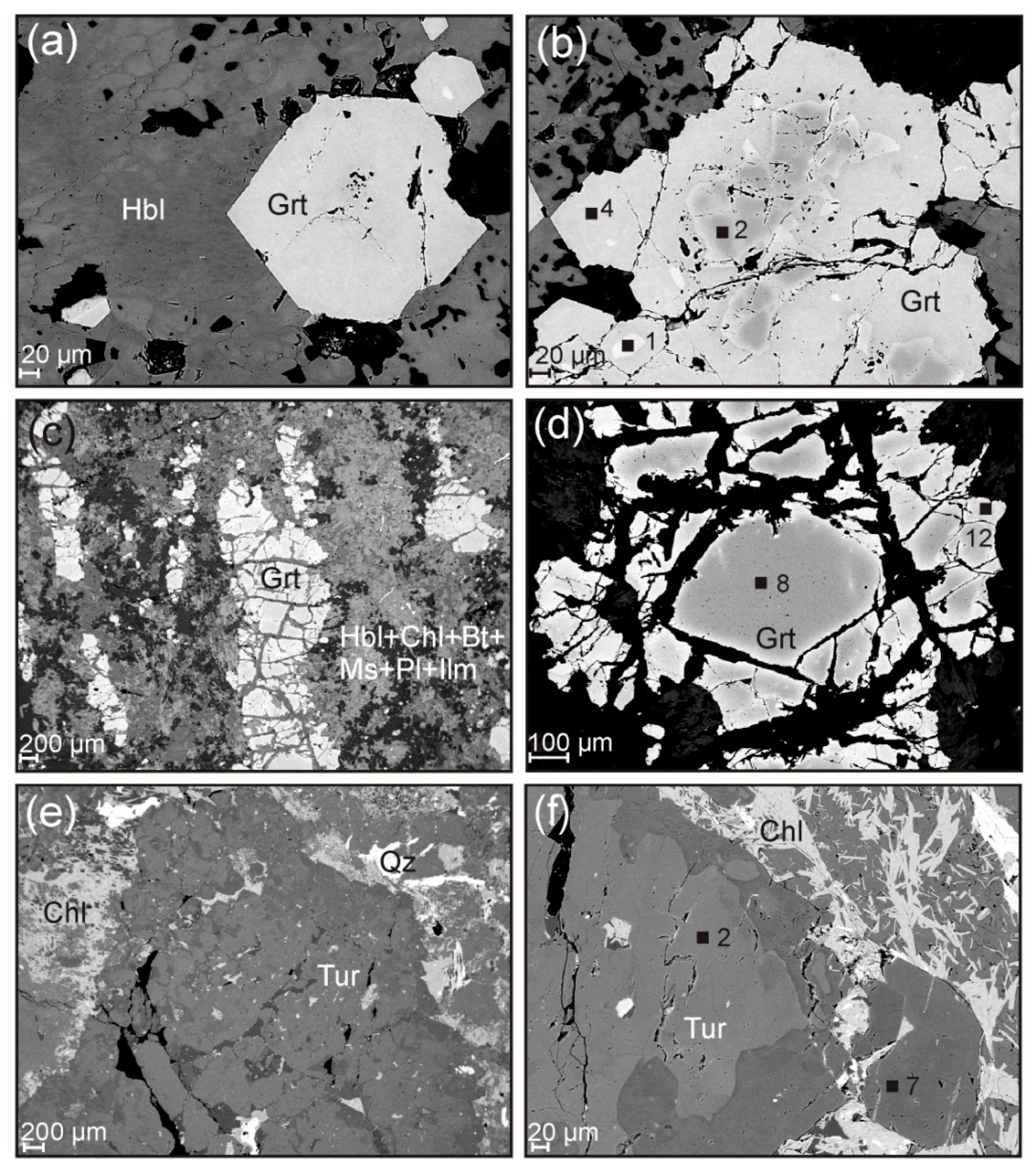
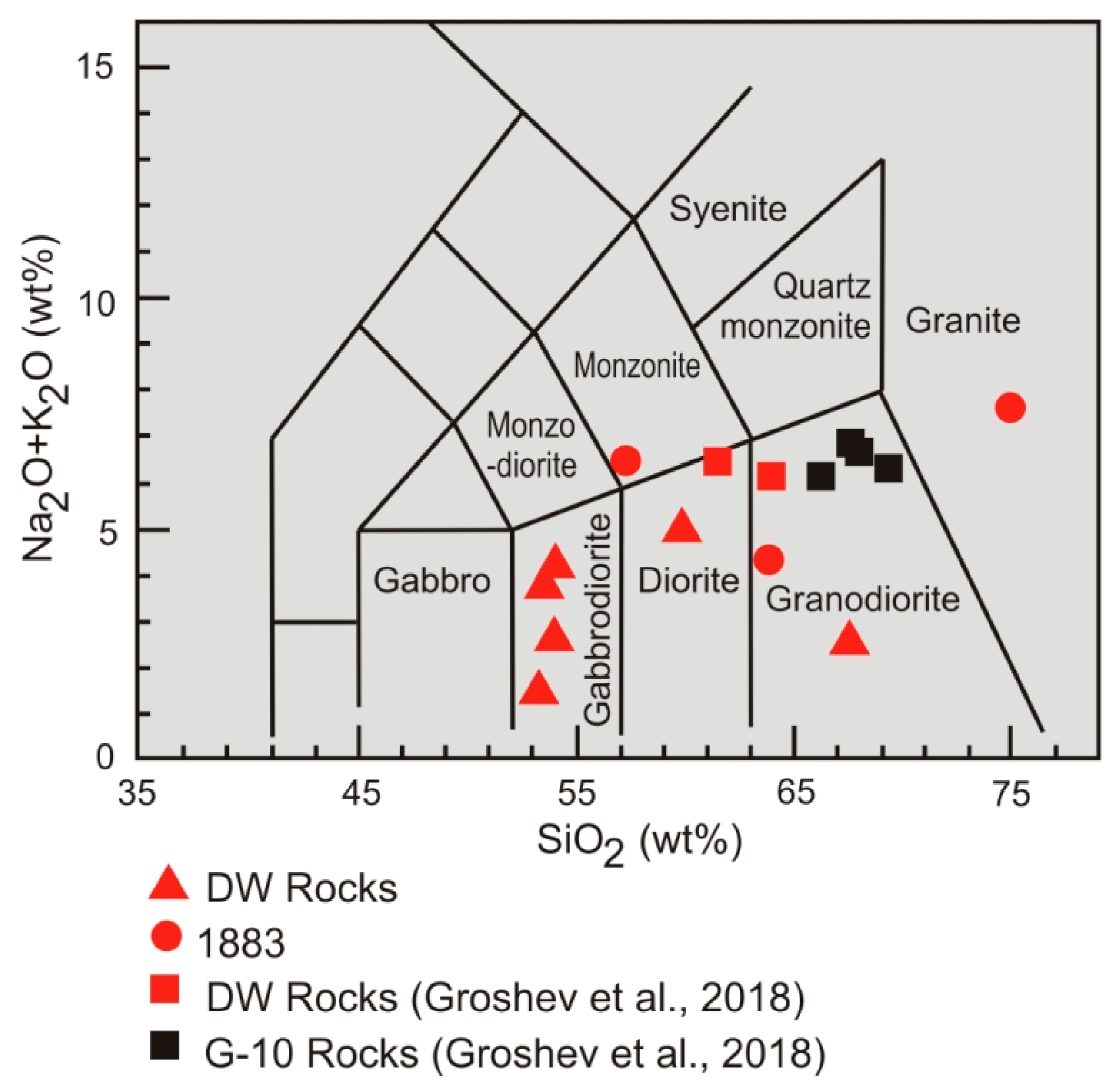

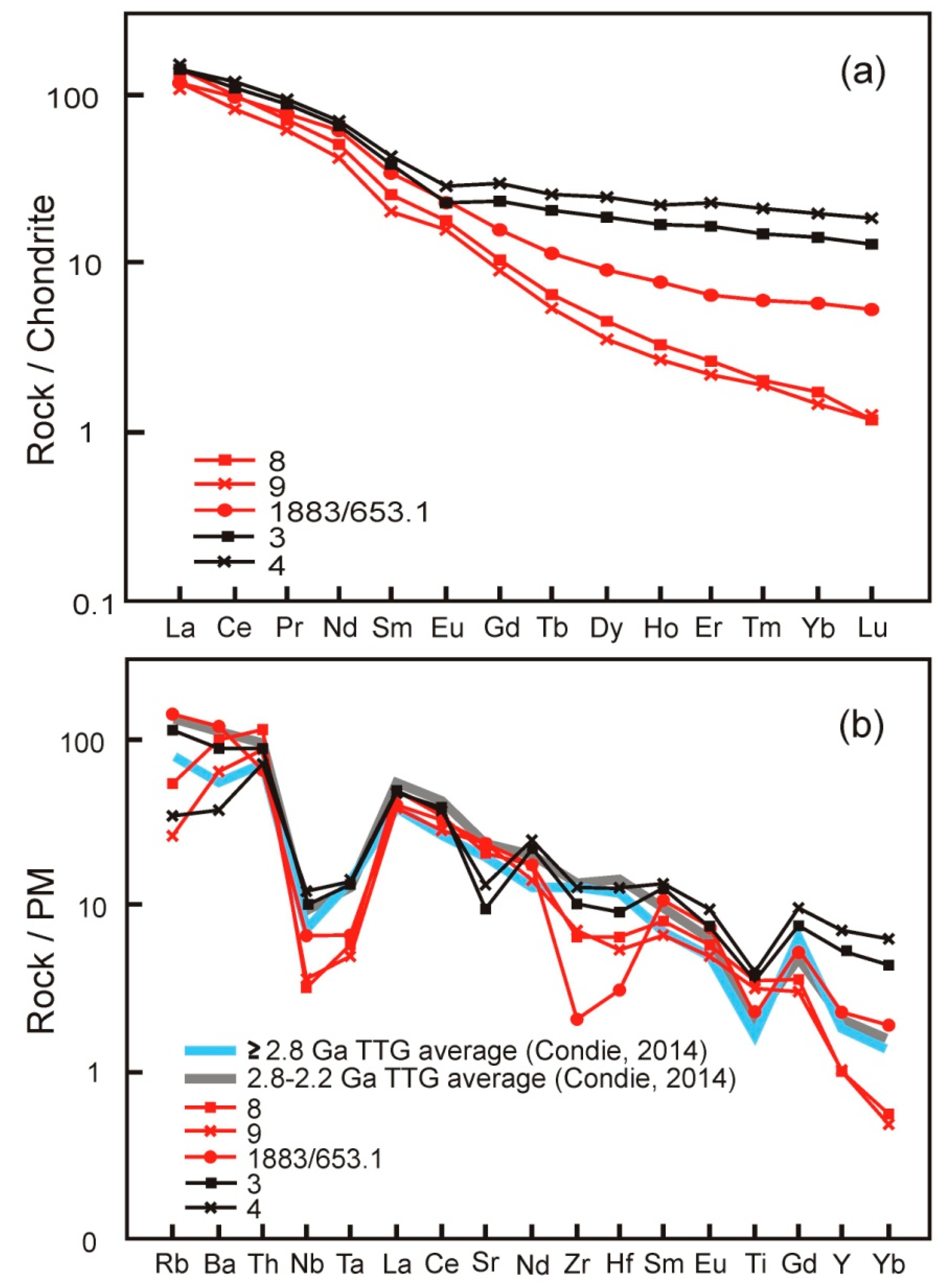
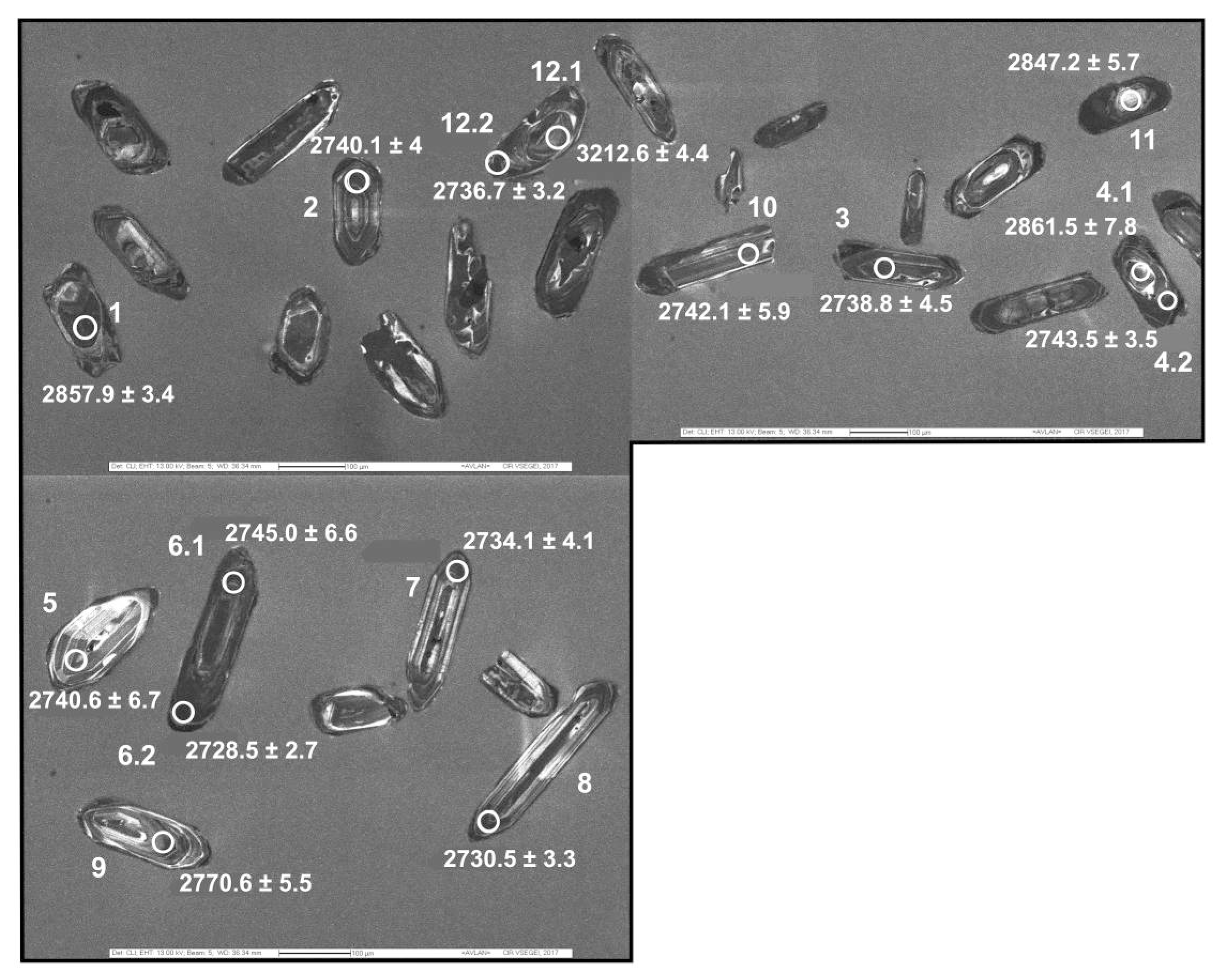
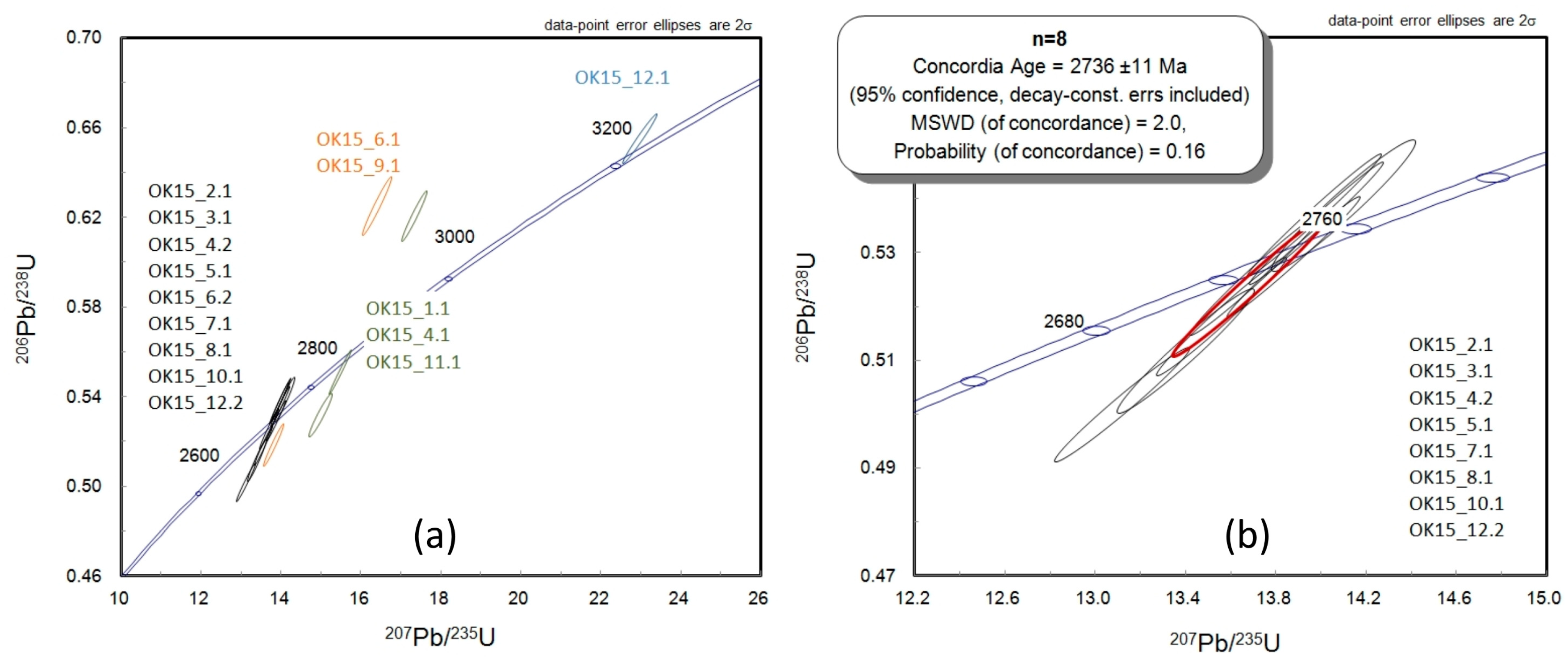
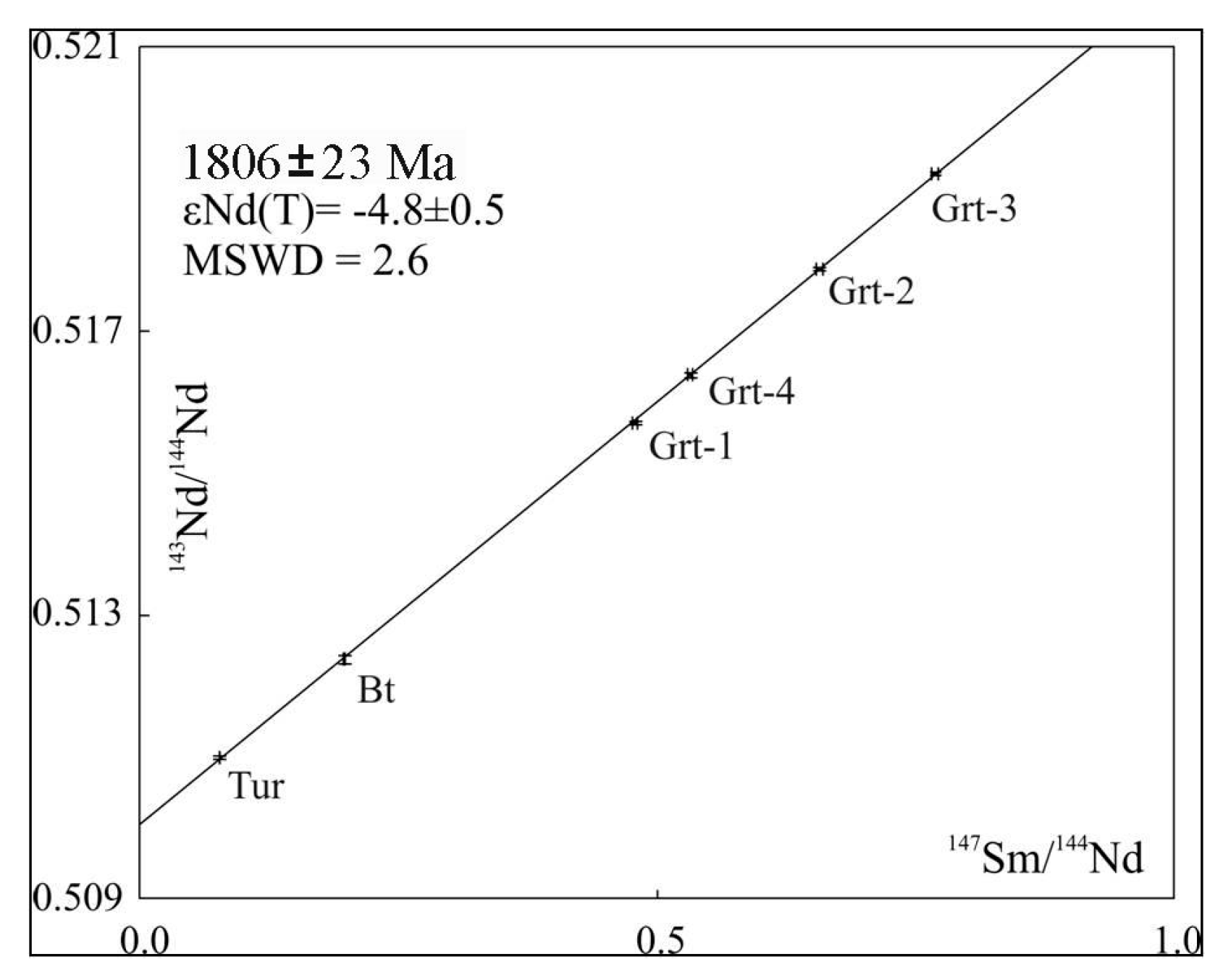
| Number | Rock Type | Thin Section Number and its Modal Composition | |
|---|---|---|---|
| OK-5 | Schistose diorite-gneiss with boudins of massive diorite-gneiss fine-grained | OK-5 | plagioclase (50%), chlorite (27%), biotite (15%), quartz (2%), epidote group minerals (1%), zircon (a few grains), ore minerals (5%) |
| OK-5a | plagioclase (75%), chlorite (10%), biotite (10%), carbonate (1%), amphibole (2%), epidote group minerals (3%), zircon (a few grains), apatite (a few grains) | ||
| OK-5b | plagioclase (29%), quartz (7%), biotite (15%), chlorite (20%), garnet (a few grains), amphibole (18%), carbonate (5%), epidote group minerals (2%) | ||
| OK-5c | Light part: plagioclase (75%), quartz (5%), biotite (3%), ilmenite (1%), chlorite (5%), amphibole (11%), apatite (a few grains); Dark part: plagioclase (25%), quartz (30%), biotite (10%), ilmenite (2%), chlorite (33%), apatite (a few grains) | ||
| OK-5d | plagioclase (40%), biotite (22%), amphibole (15%), chlorite (10%), quartz (5%), epidote group minerals (a few grains), ore minerals (8%) | ||
| OK-6 | Schistose diorite-gneiss fine-grained, with boudin of amphibolites saturated with magnetite, garnet, and biotite | OK-6 | plagioclase (45%), quartz (10%), amphibole (15%), biotite (20%), epidote group minerals (3%), ore minerals (7%), allanite (a few grains) |
| OK-6a | amphibole (40%), quartz (20%), garnet (20%), plagioclase (5%), biotite (a few grains), epidote group minerals (2%), ore minerals (13%), apatite (a few grains) | ||
| OK-7 | Diorite-gneiss with garnet nests, inequigranular | OK-7 | plagioclase (40%), biotite (38%), chlorite (10%), quartz (2%), epidote group minerals (3%), ore minerals (7%) |
| OK-7a | plagioclase (23%), biotite (15%), chlorite (18%), garnet (30%), amphibole (10%), titanite (a few grains), ore minerals (4%) | ||
| OK-8 | Diorite-gneiss with tourmaline nests, inequigranular | OK-8 | plagioclase (30%), biotite (15%), chlorite (13%), quartz (25%), garnet (5%), amphibole (8%), epidote group minerals (a few grains), ore minerals (4%), zircon (a few grains) |
| OK-8a | tourmaline (37%), plagioclase (25%), biotite (8%), chlorite (20%), quartz (5%), ore minerals (5%), zircon (a few grains) | ||
| OK-9 | Diorite-gneiss fine-grained | plagioclase (30%), quartz (25%), biotite (7%), chlorite (13%), amphibole (20%), garnet (5%), zircon (a few grains), ore minerals (a few grains) | |
| OK-10 | The material of a granite vein crossing diorite-gneiss | quartz (80%), feldspar (12%), chlorite (8%), allanite (a few grains), ore minerals (1%) | |
| OK-15 | Diorite-gneiss fine-grained | plagioclase (35%), quartz (15%), biotite (18%), amphibole (15%), chlorite (10%), epidote group minerals (2%), ore minerals (5%), zircon (a few grains) | |
| 1883/631.2 | Biotite gneiss fine-grained | plagioclase (55%), quartz (25%), biotite (15%), amphibole (5%), chlorite (10%) | |
| 1883/653.1 | Biotite gneiss fine-grained | plagioclase (35%), quartz (15%), biotite (25%), amphibole (15%), ore minerals (2%), titanite (8%), apatite (a few grains) | |
| 1883/733.6 | Biotite gneiss fine-grained | plagioclase (45%), quartz (15%), biotite (25%), amphibole (15%), chlorite (10%), epidote group minerals (4%), ore minerals (1%) | |
| Element | 1 | 2 | 3 | 4 | 5 | 6 | 7 |
|---|---|---|---|---|---|---|---|
| Hard Core | Selvage | ||||||
| SiO2 | 37.78 | 33.374 | 33.525 | 33.159 | 32.702 | 35.812 | 35.217 |
| TiO2 | 1.08 | 0.594 | 0.968 | 1.097 | 1.550 | 0.701 | 0.332 |
| Al2O3 | 33.38 | 29.838 | 30.844 | 29.040 | 29.564 | 30.780 | 31.422 |
| Cr2O3 | 0.06 | 0.000 | 0.000 | 0.074 | 0.091 | 0.000 | 0.115 |
| V2O5 | 0.11 | n.d. | n.d. | n.d. | n.d. | n.d. | n.d. |
| FeOtotal | n.d. | 7.851 | 7.282 | 8.091 | 8.020 | 6.857 | 6.308 |
| Fe2O3 | 7.13 | n.d. | n.d. | n.d. | n.d. | n.d. | n.d. |
| FeO | 1.80 | n.d. | n.d. | n.d. | n.d. | n.d. | n.d. |
| MnO | 0.012 | 0.000 | 0.000 | 0.000 | 0.000 | 0.000 | 0.000 |
| MgO | 7.41 | 7.005 | 6.874 | 6.521 | 6.199 | 7.136 | 6.855 |
| CaO | 2.14 | 2.466 | 2.594 | 2.178 | 2.257 | 1.060 | 0.534 |
| Na2O | 0.62 | 1.005 | 1.032 | 1.281 | 1.099 | 1.627 | 1.543 |
| K2O | 0.10 | 0.051 | 0.062 | 0.059 | 0.065 | 0.034 | 0.027 |
| H2O− | 0.28 | n.d. | n.d. | n.d. | n.d. | n.d. | n.d. |
| LOI | 1.45 | n.d. | n.d. | n.d. | n.d. | n.d. | n.d. |
| F | 0.21 | n.d. | n.d. | n.d. | n.d. | n.d. | n.d. |
| Cl | 0.019 | n.d. | n.d. | n.d. | n.d. | n.d. | n.d. |
| Li2O | 0.001 | n.d. | n.d. | n.d. | n.d. | n.d. | n.d. |
| B2O3 | 5.70 | n.d. | n.d. | n.d. | n.d. | n.d. | n.d. |
| Total | 99.28 | 82.184 | 83.181 | 81.500 | 81.547 | 84.007 | 82.353 |
| 1 | 2 | 3 | 4 | 5 | 6 | 7 | 8 | 9 | 10 | 11 | 12 | 13 | |
|---|---|---|---|---|---|---|---|---|---|---|---|---|---|
| Samples | OK-6 | OK-7 | |||||||||||
| Hard Core | Selvage | Hard Core | Selvage | ||||||||||
| SiO2 | 36.489 | 36.802 | 37.055 | 37.144 | 36.279 | 38.511 | 38.585 | 38.118 | 38.104 | 37.746 | 38.212 | 36.889 | 36.757 |
| Al2O3 | 20.219 | 20.358 | 20.528 | 20.260 | 20.032 | 21.363 | 21.330 | 21.116 | 21.523 | 20.547 | 20.896 | 20.868 | 20.979 |
| Cr2O3 | 0.000 | 0.000 | 0.000 | 0.000 | 0.000 | 0.063 | 0.104 | 0.084 | 0.094 | 0.104 | 0.075 | 0.066 | 0.143 |
| FeO total | 36.030 | 32.328 | 33.560 | 31.813 | 32.100 | 31.460 | 31.955 | 32.229 | 32.227 | 31.753 | 32.855 | 33.473 | 33.437 |
| MnO | 3.272 | 1.961 | 3.164 | 3.190 | 2.970 | 0.926 | 0.765 | 2.466 | 1.119 | 6.450 | 3.339 | 4.278 | 3.760 |
| MgO | 2.092 | 4.555 | 3.299 | 0.911 | 0.984 | 6.374 | 6.376 | 5.176 | 5.740 | 2.283 | 3.753 | 3.266 | 3.139 |
| CaO | 1.312 | 1.743 | 1.787 | 5.973 | 6.050 | 1.492 | 1.532 | 1.135 | 1.427 | 1.458 | 1.443 | 1.174 | 1.299 |
| Total | 99.414 | 97.747 | 99.393 | 99.291 | 98.415 | 100.189 | 100.647 | 100.324 | 100.234 | 100.341 | 100.573 | 100.014 | 99.514 |
| Formula coefficients | |||||||||||||
| Si | 5.978 | 5.999 | 5.999 | 6.047 | 5.977 | 6.036 | 6.025 | 6.028 | 6.002 | 6.079 | 6.077 | 5.956 | 5.961 |
| Al | 0.030 | 0.028 | |||||||||||
| Total Z | 5.978 | 5.999 | 5.999 | 6.047 | 5.977 | 6.036 | 6.025 | 6.028 | 6.002 | 6.079 | 6.077 | 5.986 | 5.989 |
| Al | 3.904 | 3.912 | 3.917 | 3.888 | 3.891 | 3.946 | 3.926 | 3.936 | 3.996 | 3.900 | 3.916 | 3.942 | 3.983 |
| Fe +3 | 0.110 | 0.088 | 0.084 | 0.081 | 0.125 | 0.023 | 0.050 | 0.034 | 0.034 | 0.027 | 0.050 | ||
| Cr | 0.007 | 0.013 | 0.011 | 0.011 | 0.013 | 0.009 | 0.008 | 0.017 | |||||
| Total Y | 4.014 | 4.000 | 4.001 | 3.969 | 4.016 | 3.976 | 3.989 | 3.981 | 4.007 | 3.947 | 3.952 | 4.000 | 4.000 |
| Mg | 0.511 | 1.106 | 0.796 | 0.221 | 0.242 | 1.489 | 1.484 | 1.22 | 1.348 | 0.548 | 0.890 | 0.786 | 0.759 |
| Fe +2 | 4.827 | 4.319 | 4.460 | 4.250 | 4.299 | 4.101 | 4.123 | 4.229 | 4.245 | 4.242 | 4.330 | 4.470 | 4.535 |
| Mn | 0.454 | 0.270 | 0.434 | 0.440 | 0.415 | 0.123 | 0.101 | 0.331 | 0.149 | 0.880 | 0.450 | 0.585 | 0.516 |
| Ca | 0.230 | 0.305 | 0.310 | 1.042 | 1.068 | 0.250 | 0.256 | 0.192 | 0.240 | 0.252 | 0.246 | 0.203 | 0.226 |
| Total X | 6.022 | 6.000 | 6.000 | 5.953 | 6.024 | 5.963 | 5.964 | 5.972 | 5.982 | 5.922 | 5.916 | 6.044 | 6.036 |
| Molecular percentages of the final members of the garnet group | |||||||||||||
| almandine | 80.2 | 72.0 | 74.3 | 71.4 | 71.4 | 68.8 | 69.1 | 70.8 | 71.0 | 71.6 | 73.2 | 74.0 | 75.1 |
| andradite | 2.7 | 2.2 | 2.1 | 2.0 | 3.1 | 0.6 | 1.3 | 0.9 | 0 | 0.9 | 0.7 | 1.2 | 0 |
| grossular | 1.1 | 2.9 | 3.1 | 15.5 | 14.6 | 3.4 | 2.7 | 2.1 | 3.7 | 3.1 | 3.2 | 1.9 | 3.3 |
| pyrope | 8.5 | 18.4 | 13.3 | 3.7 | 4.0 | 25.0 | 24.9 | 20.4 | 22.5 | 9.3 | 15.0 | 13.0 | 12.6 |
| spessartine | 7.5 | 4.5 | 7.2 | 7.4 | 6.9 | 2.1 | 1.7 | 5.5 | 2.5 | 14.9 | 7.6 | 9.7 | 8.5 |
| uvarovite | 0 | 0 | 0 | 0 | 0 | 0.2 | 0.3 | 0.3 | 0.3 | 0.3 | 0.2 | 0.2 | 0.4 |
| Consecutive Number | 1 | 2 | 3 | 4 | 5 | 6 | 7 | 8 | 9 | 10 | 11 | 12 | 13 | 14 | 15 | 16 |
|---|---|---|---|---|---|---|---|---|---|---|---|---|---|---|---|---|
| Sample | OK 5a | OK 5b | OK 6 | OK 7 | OK 8 | OK 9 | 8 | 9 | OK 10 | 1883/ 631.2 | 1883/ 653.1 | 1883/ 733.6 | 1 | 2 | 3 | 4 |
| SiO2 | 53.89 | 53.52 | 53.30 | 59.82 | 54.16 | 67.60 | 63.87 | 61.33 | 91.71 | 74.92 | 57.14 | 63.81 | 67.64 | 68.15 | 69.39 | 66.27 |
| TiO2 | 0.89 | 1.05 | 0.43 | 0.41 | 1.19 | 0.55 | 0.78 | 0.7 | <0.01 | 0.03 | 0.65 | 0.58 | 0.62 | 0.62 | 0.76 | 0.85 |
| Al2O3 | 17.06 | 20.03 | 10.06 | 19.94 | 18.10 | 12.84 | 17.38 | 17.8 | 2.80 | 12.86 | 17.92 | 16.22 | 12.62 | 12.12 | 11.92 | 11.95 |
| Cr2O3 | 0.045 | 0.032 | <0.005 | 0.079 | 0.038 | 0.032 | b.d.l. | 0.007 | 0.030 | 0.049 | 0.02 | <0.006 | 0.007 | 0.007 | b.d.l. | b.d.l. |
| V2O5 | 0.037 | 0.058 | 0.12 | <0.025 | 0.040 | <0.025 | 0.025 | b.d.l. | 0.010 | 0.036 | 0.054 | 0.049 | b.d.l. | b.d.l. | 0.02 | 0.011 |
| Fe2O3 | 2.57 | 2.09 | 6.77 | 1.08 | 2.70 | 1.14 | 1.59 | 1.37 | 0.00 | 0.00 | 2.05 | 1.15 | 3.34 | 3.18 | 2.6 | 2.94 |
| FeO | 6.95 | 6.35 | 12.02 | 3.35 | 7.07 | 5.41 | 3.06 | 3.57 | 1.82 | 1.76 | 3.52 | 3.71 | 3.01 | 2.87 | 3.16 | 4.2 |
| MnO | 0.12 | 0.077 | 0.24 | 0.056 | 0.14 | 0.062 | 0.05 | 0.05 | 0.021 | 0.022 | 0.073 | 0.064 | 0.1 | 0.1 | 0.12 | 0.1 |
| MgO | 5.73 | 4.58 | 1.56 | 1.82 | 4.39 | 1.84 | 1.84 | 2.18 | 0.12 | 0.28 | 3.94 | 3.2 | 0.98 | 0.94 | 1.07 | 1.16 |
| CaO | 5.27 | 4.15 | 9.03 | 5.49 | 3.38 | 4.16 | 3.55 | 5.59 | 0.82 | 1.53 | 4.85 | 4.03 | 2.54 | 3.13 | 2.89 | 3.08 |
| Na2O | 1.86 | 2.73 | 0.93 | 4.55 | 2.96 | 2.33 | 4.39 | 4.86 | 1.01 | 6.87 | 3.76 | 3.68 | 4.28 | 4.15 | 3.56 | 5.4 |
| K2O | 0.73 | 0.95 | 0.47 | 0.48 | 1.16 | 0.24 | 1.74 | 0.77 | 0.27 | 0.68 | 2.84 | 0.49 | 2.48 | 2.52 | 2.78 | 0.76 |
| H2O− | 0.29 | 0.29 | 0.16 | 0.20 | 0.33 | 0.16 | 0.24 | 0.22 | 0.06 | 0.15 | 0.26 | 0.23 | 0.28 | 0.26 | 0.2 | 0.14 |
| LOI | 4.30 | 3.45 | 2.34 | 1.75 | 3.41 | 2.00 | 1.36 | 1.54 | 0.55 | 0.65 | 2.22 | 0.94 | 1.31 | 1.29 | 1.00 | 1.38 |
| P2O5 | 0.17 | 0.08 | 0.34 | 0.05 | 0.05 | 0.08 | n.d. | n.d. | 0.01 | 0.02 | 0.19 | 0.17 | 0.2 | 0.19 | 0.18 | 0.21 |
| F | 0.036 | 0.039 | 0.031 | 0.015 | 0.033 | 0.014 | n.d. | n.d. | 0.004 | n.d. | n.d. | n.d. | n.d. | n.d. | n.d. | n.d. |
| Cl | 0.027 | 0.032 | 0.55 | 0.019 | 0.058 | 0.047 | n.d. | n.d. | 0.026 | 0.01 | 0.012 | 0.011 | n.d. | n.d. | n.d. | n.d. |
| Cu | <0.01 | <0.01 | 0.07 | <0.01 | <0.01 | 0.014 | n.d. | n.d. | <0.01 | ≤0.01 | ≤0.01 | ≤0.01 | n.d. | n.d. | n.d. | n.d. |
| Ni | 0.013 | 0.014 | 0.016 | 0.013 | 0.014 | 0.012 | n.d. | n.d. | 0.015 | ≤0.01 | 0.012 | 0.014 | n.d. | n.d. | n.d. | n.d. |
| Co | <0.01 | <0.01 | 0.011 | <0.01 | <0.01 | <0.01 | n.d. | n.d. | <0.01 | ≤0.01 | ≤0.01 | ≤0.01 | n.d. | n.d. | n.d. | n.d. |
| CO2 | 0.33 | ≤0.01 | 0.31 | ≤0.1 | ≤0.1 | ≤0.1 | b.d.l. | 0.1 | 0.10 | 0.28 | 0.18 | 1.28 | b.d.l. | b.d.l. | b.d.l. | 0.83 |
| Stotal | 0.06 | 0.05 | 1.70 | 0.10 | 0.14 | 0.51 | 0.04 | 0.03 | 0.07 | 0.05 | 0.02 | 0.01 | 0.06 | 0.04 | 0.1 | 0.22 |
| Total | 100.38 | 99.57 | 100.44 | 99.22 | 99.36 | 99.04 | 99.91 | 100.12 | 99.45 | 99.9 | 99.71 | 99.64 | 99.47 | 99.57 | 99.75 | 99.50 |
| Gneiss | Metadiorite | Gneiss | Metadiorite | ||||||||
|---|---|---|---|---|---|---|---|---|---|---|---|
| Sample | 8 | 9 | 3 | 4 | Sample | 8 | 9 | 3 | 4 | ||
| 1809/58.1 | 1810/62.8 | 1883/653.1 | 1810/11.1 | 1810/18.3 | 1809/58.1 | 1810/62.8 | 1883/653.1 | 1810/11.1 | 1810/18.3 | ||
| Li | 11.53 | 4.38 | 23.29 | 8.16 | 3.23 | Ba | 675.23 | 426.61 | 843.04 | 640.60 | 254.71 |
| Be | 0.65 | 0.46 | 1.17 | 1.03 | 0.79 | La | 33.27 | 26.31 | 28.12 | 32.83 | 31.81 |
| Sc | 5.31 | 6.47 | 14.30 | 13.31 | 13.67 | Ce | 60.90 | 49.98 | 59.25 | 69.03 | 69.17 |
| Ti | 2758.81 | 2959.95 | 2879.26 | 2996.12 | 3137.96 | Pr | 6.74 | 5.53 | 7.32 | 8.22 | 8.36 |
| V | 62.52 | 81.75 | 105.67 | 46.57 | 20.17 | Nd | 23.56 | 19.53 | 28.01 | 30.21 | 32.36 |
| Cr | 40.54 | 47.18 | 125.67 | 18.41 | 44.26 | Sm | 3.64 | 2.95 | 4.99 | 5.64 | 6.23 |
| Mn | 295.75 | 310.93 | 399.60 | 768.36 | 671.06 | Eu | 0.97 | 0.87 | 1.30 | 1.25 | 1.59 |
| Co | 10.99 | 14.17 | 18.77 | 11.08 | 13.85 | Gd | 2.13 | 1.85 | 3.14 | 4.65 | 5.87 |
| Ni | 27.51 | 41.13 | 64.88 | 18.29 | 22.33 | Tb | 0.25 | 0.20 | 0.40 | 0.72 | 0.93 |
| Cu | 22.52 | 53.64 | 8.97 | 43.40 | 100.50 | Dy | 1.14 | 0.89 | 2.25 | 4.39 | 5.75 |
| Zn | 59.82 | 58.85 | 54.90 | 58.69 | 35.01 | Ho | 0.18 | 0.15 | 0.41 | 0.91 | 1.21 |
| Ga | 20.18 | 22.61 | 18.30 | 15.55 | 15.70 | Er | 0.42 | 0.37 | 1.07 | 2.66 | 3.64 |
| Ge | 0.59 | 0.57 | 1.14 | 1.05 | 0.97 | Tm | 0.05 | 0.05 | 0.15 | 0.37 | 0.51 |
| Rb | 34.46 | 15.94 | 90.66 | 74.35 | 21.51 | Yb | 0.28 | 0.25 | 0.97 | 2.30 | 3.17 |
| Sr | 432.02 | 494.52 | 493.84 | 210.24 | 265.57 | Lu | 0.04 | 0.03 | 0.13 | 0.32 | 0.45 |
| Y | 4.45 | 4.46 | 10.36 | 24.00 | 32.00 | Hf | 2.01 | 1.65 | 0.94 | 3.00 | 3.89 |
| Zr | 75.65 | 81.76 | 23.60 | 117.80 | 148.18 | Ta | 0.23 | 0.21 | 0.28 | 0.56 | 0.57 |
| Nb | 2.30 | 2.64 | 4.88 | 7.42 | 8.51 | W | n.d. | n.d. | 0.40 | n.d. | n.d. |
| Mo | 1.57 | 2.30 | 1.79 | 2.28 | 6.50 | Tl | 0.16 | 0.06 | 0.45 | 0.33 | 0.13 |
| Ag | 0.07 | 0.09 | 0.08 | 0.22 | 0.26 | Pb | 10.84 | 7.98 | 12.14 | 14.26 | 9.09 |
| Cd | n.d. | n.d. | 0.04 | 0.06 | n.d. | Bi | 0.03 | 0.01 | 0.05 | 0.07 | 0.04 |
| Sn | 0.89 | 1.72 | 1.24 | 1.67 | 3.17 | Th | 9.54 | 7.60 | 5.79 | 7.57 | 6.01 |
| Sb | 0.04 | 0.08 | 0.03 | 0.06 | 0.12 | U | 0.88 | 0.59 | 0.89 | 1.79 | 1.58 |
| Te | 0.01 | 0.00 | 0.01 | 0.02 | 0.01 | As | 0.66 | 0.99 | n.d. | 0.92 | 0.83 |
| Cs | 1.74 | 1.59 | 2.80 | 1.01 | 1.78 | ||||||
| Spot | % 206Pbc | Ppm U | Ppm Th | 232Th /238U | Ppm 206Pb* | (1) 206Pb /238U Age | (1) 207Pb/206Pb Age | % Discor dance | (1) 238U/206Pb* | ±% | (1) 207Pb*/206Pb* | ±% | (1) 207Pb*/235U | ±% | (1) 206Pb*/238U | ±% | Rho |
|---|---|---|---|---|---|---|---|---|---|---|---|---|---|---|---|---|---|
| OK15_1.1 | 0.02 | 558 | 107 | 0.2 | 264 | 2829 ± 34 | 2857.9 ± 3.4 | 1 | 1.815 | 1.5 | 0.20392 | 0.21 | 15.49 | 1.5 | 0.5509 | 1.5 | 0.991 |
| OK15_2.1 | 0.05 | 405 | 291 | 0.74 | 180 | 2691 ± 31 | 2740.1 ± 4 | 2 | 1.93 | 1.4 | 0.18976 | 0.25 | 13.56 | 1.4 | 0.5181 | 1.4 | 0.985 |
| OK15_3.1 | 0.01 | 343 | 329 | 0.99 | 148 | 2621 ± 31 | 2738.8 ± 4.5 | 4 | 1.993 | 1.4 | 0.18962 | 0.27 | 13.12 | 1.5 | 0.5017 | 1.4 | 0.982 |
| OK15_4.1 | 0.09 | 111 | 47 | 0.44 | 50.9 | 2749 ± 34 | 2861.5 ± 7.8 | 4 | 1.88 | 1.5 | 0.20438 | 0.48 | 14.99 | 1.6 | 0.5318 | 1.5 | 0.953 |
| OK15_5.1 | 0.03 | 147 | 81 | 0.57 | 68.1 | 2779 ± 33 | 2740.6 ± 6.7 | −1 | 1.856 | 1.5 | 0.18982 | 0.41 | 14.1 | 1.5 | 0.5388 | 1.5 | 0.964 |
| OK15_4.2 | 0 | 536 | 489 | 0.94 | 244 | 2738 ± 31 | 2743.5 ± 3.5 | 0 | 1.889 | 1.4 | 0.19016 | 0.21 | 13.88 | 1.4 | 0.5292 | 1.4 | 0.989 |
| OK15_6.1 | 0.05 | 601 | 359 | 0.62 | 323 | 3131 ± 42 | 2745 ± 6.6 | −12 | 1.599 | 1.7 | 0.19033 | 0.4 | 16.41 | 1.8 | 0.625 | 1.7 | 0.973 |
| OK15_7.1 | 0.01 | 385 | 244 | 0.65 | 174 | 2724 ± 31 | 2734.1 ± 4.1 | 0 | 1.902 | 1.4 | 0.18907 | 0.25 | 13.71 | 1.4 | 0.5258 | 1.4 | 0.985 |
| OK15_8.1 | 0.01 | 640 | 396 | 0.64 | 295 | 2771 ± 32 | 2730.5 ± 3.3 | −1 | 1.862 | 1.4 | 0.18866 | 0.2 | 13.97 | 1.4 | 0.537 | 1.4 | 0.99 |
| OK15_9.1 | 0.04 | 218 | 126 | 0.6 | 97.1 | 2693 ± 32 | 2770.6 ± 5.5 | 3 | 1.929 | 1.5 | 0.19332 | 0.33 | 13.82 | 1.5 | 0.5185 | 1.5 | 0.974 |
| OK15_6.2 | 0.01 | 899 | 33 | 0.04 | 416 | 2779 ± 32 | 2728.5 ± 2.7 | −2 | 1.856 | 1.4 | 0.18843 | 0.17 | 14 | 1.4 | 0.5389 | 1.4 | 0.993 |
| OK15_10.1 | 0.06 | 202 | 157 | 0.8 | 88.7 | 2664 ± 32 | 2742.1 ± 5.9 | 3 | 1.954 | 1.5 | 0.18999 | 0.36 | 13.4 | 1.5 | 0.5117 | 1.5 | 0.971 |
| OK15_11.1 | 0.06 | 169 | 85 | 0.52 | 90.3 | 3112 ± 36 | 2847.2 ± 5.7 | −9 | 1.611 | 1.5 | 0.20259 | 0.35 | 17.34 | 1.5 | 0.6206 | 1.5 | 0.972 |
| OK15_12.1 | 0.03 | 203 | 82 | 0.42 | 114 | 3248 ± 37 | 3212.6 ± 4.4 | −1 | 1.527 | 1.4 | 0.25443 | 0.28 | 22.98 | 1.5 | 0.6551 | 1.4 | 0.981 |
| OK15_12.2 | 0.03 | 686 | 942 | 1.42 | 315 | 2764 ± 32 | 2736.7 ± 3.2 | −1 | 1.868 | 1.4 | 0.18937 | 0.2 | 13.98 | 1.4 | 0.5355 | 1.4 | 0.99 |
| Sample | Mineral | Concentration, ppm | Isotopic Ratio | εNd(T) | ||
|---|---|---|---|---|---|---|
| Sm | Nd | 147Sm/144Nd | 143Nd/144Nd | |||
| OK-8 | Tourmaline | 2.08 | 16.33 | 0.0771 | 0.510998 ± 19 | −4.4 |
| OK-7 | Biotite | 1.506 | 4.60 | 0.1978 | 0.512378 ± 29 | −5.4 |
| OK-7 | Garnet-1 | 3.31 | 4.17 | 0.4790 | 0.515701 ± 18 | −5.5 |
| OK-7 | Garnet-2 | 3.75 | 3.45 | 0.6575 | 0.517877 ± 17 | −4.3 |
| OK-7 | Garnet-3 | 3.54 | 2.78 | 0.7695 | 0.519221 ± 26 | −3.9 |
| OK-7 | Garnet-4 | 4.42 | 5.02 | 0.5324 | 0.516383 ± 29 | −4.5 |
| Period (Billion Years) | Event |
|---|---|
| 1.9–1.8 | Svecofennian orogeny accompanied by tectonic processing and metamorphism of basement rocks (boudinage, formation of the amphibole-garnet-tourmaline association). |
| 2.5–2.4 | 2.5–0.002 Ga—incoming of additional late intrusive phases of the Monchegorsk complex and their differentiation (gabbronorite-gabbro-diorite), formation of a magnetite layer of the Gabbro-10 massif and sulfide Cu-Ni-PGE deposits, intensive penetration of sulfide mineralization (Cu/Ni = 2) into the basement diorite. 2.5 + 0.004 Ga—incoming of the main intrusive phase of the Monchegorsk complex (in particular, norite-pyroxenite of the Nude-Poaz massif), formation of sulfide Cu-Ni-PGE deposits, partial penetration of sulfide mineralization (Cu/Ni = 1) into the basement diorite. |
| 2.8–2.7 | Magmatic crystallization of rocks of the Archean basement and subsequent metamorphism and migmatization, when diorite-gneisses were formed. |
© 2020 by the authors. Licensee MDPI, Basel, Switzerland. This article is an open access article distributed under the terms and conditions of the Creative Commons Attribution (CC BY) license (http://creativecommons.org/licenses/by/4.0/).
Share and Cite
Pripachkin, P.; Rundkvist, T.; Groshev, N.; Bazai, A.; Serov, P. Archean Rocks of the Diorite Window Block in the Southern Framing of the Monchegorsk (2.5 Ga) Layered Mafic-Ultramafic Complex (Kola Peninsula, Russia). Minerals 2020, 10, 848. https://doi.org/10.3390/min10100848
Pripachkin P, Rundkvist T, Groshev N, Bazai A, Serov P. Archean Rocks of the Diorite Window Block in the Southern Framing of the Monchegorsk (2.5 Ga) Layered Mafic-Ultramafic Complex (Kola Peninsula, Russia). Minerals. 2020; 10(10):848. https://doi.org/10.3390/min10100848
Chicago/Turabian StylePripachkin, Pavel, Tatiana Rundkvist, Nikolay Groshev, Aiya Bazai, and Pavel Serov. 2020. "Archean Rocks of the Diorite Window Block in the Southern Framing of the Monchegorsk (2.5 Ga) Layered Mafic-Ultramafic Complex (Kola Peninsula, Russia)" Minerals 10, no. 10: 848. https://doi.org/10.3390/min10100848





